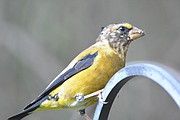Evening grosbeaks: Magnificent but elusive
Last weekend I was scanning the ponderosa pines surrounding my bird feeders when some unfamiliar birds caught my eye. I reached for my Nikon with my 600 mm lens to take a picture of the birds. Suddenly they weren’t just birds; they were spectacular and handsomely attired in yellow, black and white. They were about the size of a robin, but more compact and thicker bodied; smaller than a Steller’s jay
I quickly consulted my “Birds of Idaho” field guide by Stan Tekiela and discovered they were evening grosbeaks. It is the first time that they have visited. It was a treat because there were more than a dozen of them busily feeding on my platform feeders filled with sunflower seeds.
I watched these beautiful birds as they hunted busily for just the right sunflower seed among the feeders. They weren’t especially shy and allowed me to stand fairly close and take a couple of quick photos.
It is pretty easy to see where grosbeaks get their name. All grosbeaks have enormous bills for their size. The bill is conical and thick, capable of crushing seeds far larger than other seed-eaters, such as the pine siskins. Smaller seed-eaters often follow evening grosbeaks to glean from their leavings.
Grosbeaks are members of the finch family but are far heavier-bodied than most finches. The male is the more colorful of the sexes, with a dark head, yellow eye stripe, yellow chest and white wing patches on black wings. Females and juveniles are mostly gray with black and white wings. They also have a greenish bill, while the male’s bill is lighter colored.
I wondered why this was the first time I had seen the evening grosbeaks. After researching this beautiful bird it turns out that these birds are gregarious, often moving in flocks. So seeing them is a sort of feast or famine. You may see a large group or nothing at all.
These are social birds that are often found in flocks, particularly in fall and winter. They forage in tree-tops for insect larvae during the summer, buds in spring, and seeds, berries, and small fruits in winter.
They are notorious for their wandering habit. They may visit a bird feeder one winter and then not again for several years. Evening grosbeaks may spend all year in Idaho, never really migrating, but in the eastern states, they are considered irruptive — a dramatic, irregular migration of large number of birds to areas where they aren’t typically found — showing up in great numbers some years and being scarce in others.
I look forward to my next encounter I have with the magnificent evening grosbeak. I won’t hold my breath waiting for the next time though.
Enjoy the out-of-doors in Boundary County!



